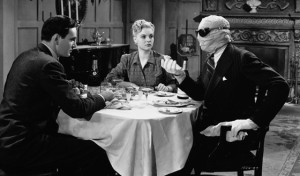 “An invisible man can rule the world”, says Claude Rains starring in the first movie version of The Invisible Man.
“An invisible man can rule the world”, says Claude Rains starring in the first movie version of The Invisible Man.
I’ve been thinking a lot about the pros and cons of being invisible, or at least anonymous, over the last week or so. Offenders have always sought to hide from the law and police officers to expose them. The development of fingerprinting, DNA analysis and ubiquitous CCTV coverage have all marked leaps forward in detection and have all been met with corresponding changes in offending skills (gloves, bleach and finding camera blindspots).
The advent of social media has merely increased the speed of change.
Invisibility/anonymity was a significant feature of the recent riots. Looters weren’t able to be invisible but tried their hardest to remain anonymous, wearing hoodies and masks and using Facebook, Twitter and, in particular, Blackberry Messaging, to organise and co-ordinate their attacks without the knowledge of the police. The police promptly utilised social media in response; they identified gang members from Youtube videos (thanks @bsbsolicitors) and used Facebook to find incriminating evidence on looters who were bragging about what they had stolen or were advertising stolen goods for sale.
The latest development that I have come across is Vibe, a new iphone app, which functions as an anonymous version of Twitter. Like Twitter, it is an open platform which allows mass instant messaging. Unlike Twitter, it is designed to be used anonymously. You can set how far you want your messages to be available – from 15 metres to global. You can also set the messages to self-destruct after a pre-determined period of time: from 15 minutes to forever. The app is being targeted at political protesters, whether it will get the level of popularity to be used in any future disturbances is open to question.
There is more evidence from the USA of social media becoming the new battleground between criminals and the forces of law and order. Probation officers routinely monitor offenders’ use of social media to uncover offending and track absconders. Indeed, a judge in Texas recently forced some offenders on probation to hand over all their social media passwords to supervising probation officers, although there is doubt that this is constitutionally acceptable. When I was a probation officer, the emphasis was on encouraging honesty and getting offenders to take responsibility for their behaviour. Although the modern service is more explicitly about monitoring behaviour, I’m not sure that trolling through Facebook pages is the best use of probation officers’ time, nor the most effective approach to promoting positive change.

None of us who Blog or Tweet want to be invisible, but quite a few like to remain anonymous. @TheCustodySgt tweets and blogs about life as a Custody Sergeant anonymously. In a thoughtful post, he describes the differences between official police tweeters and anonymous ones, like himself. He is in favour of official tweeting and the connections it makes between police services and the general public. 2011 is the year that police tweeting really took off with over 560 UK coppers on the micro-blogging site, as I recently described. @TheCustodySgt points out that official tweets might provide an invaluable public service, but they only give part of the picture. Like any public relations approach, they only broadcast the successes, not the failures, nor the day to day tribulations. One of the joys of Twitter for me is the sheer range of opinion that anyone can access. In terms of coppers on the Internet, there is a choice of @SuptPayneWMP tweeting from an international conference on Police and Social media to @SpartanCop and InspectorGadget berating Tom Winsor for his review of police pay and conditions, and most shades of opinion in between.
While only offenders may want to remain invisible, I think there’s a decent rationale for staying anonymous on the web. For us readers, it is certainly more interesting to get a fuller story with the cock-ups as well as the triumphs. In the end, the Invisible Man goes mad and embarks on a killing spree before being shot dead by police; his invisibility ultimately of no benefit. Claude Rains, however, fared rather better. The Invisible Man was his first starring role, even though he was anonymous throughout (we only see his face once, in the final scene). He went on to appear in many big movies including Notorious, Mr Smith Goes to Washington and, most famously, Casablanca, although as you can see, he was still trying to avoid detection:

A good thought provoking blog – Vibe is a bit ‘rough’ at the moment (it keeps crashing my Android phone for example) but is a really good indication of how fast technology can be deployed to address issues.
I cover a lot of these technology and social media in policing issues at my blog – http://partridgej.wordpress.com/
Can police be able to use in Isabel technology that’s out
I ment to ask is it legal for police to use in invisabel technology that’s out making it hard to see them or to see them at all this technology been around for at least 4years and have see them use it and keeps on getting better